Fastrada was queen consort of East Francia by marriage to Charlemagne, as his third wife.

Rabanus Maurus Magnentius, also known as Hrabanus or Rhabanus, was a Frankish Benedictine monk, theologian, poet, encyclopedist and military writer who became archbishop of Mainz in East Francia. He was the author of the encyclopaedia De rerum naturis. He also wrote treatises on education and grammar and commentaries on the Bible. He was one of the most prominent teachers and writers of the Carolingian age, and was called "Praeceptor Germaniae", or "the teacher of Germany". In the most recent edition of the Roman Martyrology, his feast is given as 4 February and he is qualified as a Saint ('sanctus').

Mainz Cathedral or St. Martin's Cathedral is located near the historical center and pedestrianized market square of the city of Mainz, Germany. This 1000-year-old Roman Catholic cathedral is the site of the episcopal see of the Bishop of Mainz.

Mainz Hauptbahnhof is a railway station for the city of Mainz in the German state of Rhineland-Palatinate. It is used by about 60,000 travelers and visitors each day and is therefore by far the busiest station in Rhineland-Palatinate. The station was a trial area for a CCTV scheme using automated face recognition.
Edmund Buchner was a German ancient historian and former President of the German Archaeological Institute.
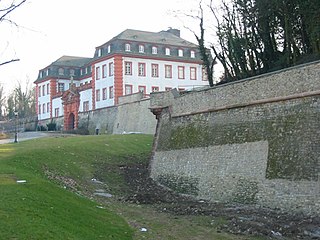
The Fortress of Mainz was a fortressed garrison town between 1620 and 1918. At the end of the Napoleonic Wars, under the term of the 1815 Peace of Paris, the control of Mainz passed to the German Confederation and became part of a chain of strategic fortresses which protected the Confederation. With the dissolution of the Confederation and the Austro-Prussian War, control of the fortress first passed to Prussia, and, after the 1871 Unification of Germany, to the German Empire.
Mainz-Drais (Drais) is a borough in the western part of Mainz. The village was suburbanised by the City of Mainz in 1969, and is now its smallest subdivision, with just over 3,000 permanent residents.

The Mainz Carnival is a months-long citywide carnival celebration in Mainz, Germany that traditionally begins on 11 November but culminates in the days before Ash Wednesday in the spring.
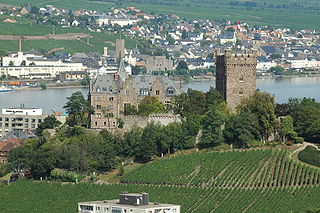
Klopp Castle is a castle in the town of Bingen am Rhein in the Upper Middle Rhine Valley in Rhineland-Palatinate, Germany. In the nineteenth century, the bergfried from the original medieval fortified castle was restored and a new building added which houses the town's administration.

The Rabanus-Maurus-Gymnasium is a classical gymnasium school in the Neustadt district of Mainz.
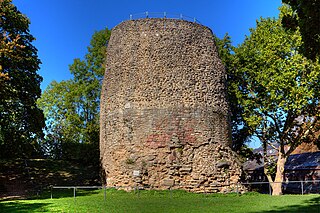
The Drususstein is a nearly 20 metres high masonry block of Roman origin on the grounds of the citadel of Mainz, Germany. It was originally cased in marble. Researchers now largely accept that this is the structural remnant of the cenotaph mentioned by writers like Eutropius and Suetonius, erected in 9 BC by Roman troops in honour of the deceased general Drusus, in Mogontiacum.
Wolfram Hoepfner is a German classicist, archaeologist, architectural historian, and Professor of Ancient Architectural History, at the Free University of Berlin.
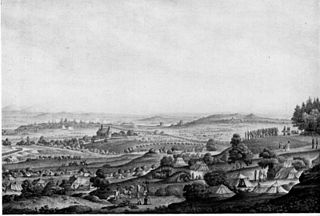
The siege of Mainz was a short engagement at the beginning of the War of the First Coalition. The victorious French army of Custine seized the town on October 21, 1792, after three days of siege. The French occupied Mainz, and tried to install the Republic of Mainz there.
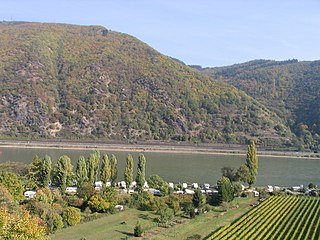
The Aresaces were Belgic tribe. They were closely related to, and probably originally part of, the Treveri. They inhabited the left bank of the Rhine in the Mainz-Bingen area, which was once the easternmost part of Treveran territory.
The following is a timeline of the history of the city of Mainz, Germany.

The Old Arsenal, also referred to as Zum Sautanz, was the central arsenal of the fortress of Mainz during the 17th and 18th century. In his function it was succeeded by the new arsenal. Currently the renaissance building is used by the Rhineland-Palatinate state chancellery and the Landtag of Rhineland-Palatinate.
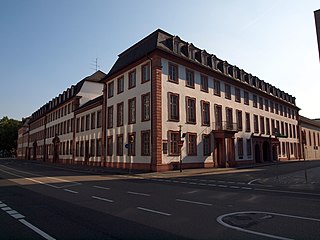
Eltzer Hof was a music venue located in Mainz, Germany. The building was constructed in 1742 in a Baroque style architecture on behalf of the Eltz dynasty. During the Bombing of Mainz in World War II the building burnt down starting 11 August 1942. The three-storey eighteen-axle baroque building with a hipped mansard roof, at Bauhofstraße 3/5 corner Mittlere Bleiche, is listed in the list of cultural monuments in Mainz-Altstadt and together with the adjacent buildings forms a monument zone.
Franz Dumont was a German historian.

The Römische Kaisermedaillon is an award presented by the city of Mainz.












